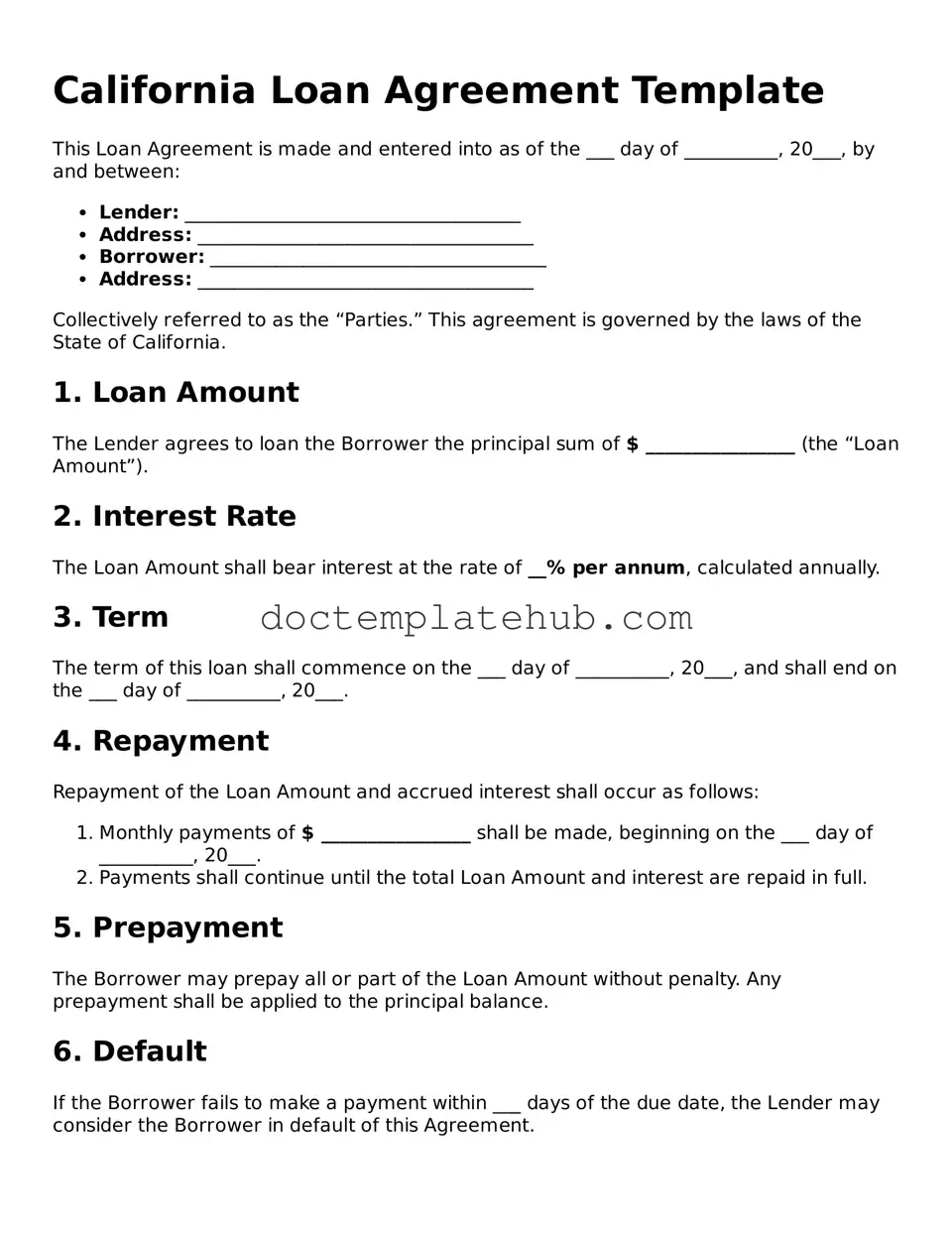The California Loan Agreement form shares similarities with the Promissory Note. A Promissory Note is a written promise to pay a specified amount of money to a lender at a defined time or on demand. Both documents outline the terms of the loan, including the principal amount, interest rate, and repayment schedule. However, while a Loan Agreement may include more detailed terms and conditions, the Promissory Note focuses primarily on the borrower's commitment to repay the loan. This makes the Promissory Note a simpler, more straightforward document in comparison.
Another document that resembles the California Loan Agreement is the Mortgage Agreement. A Mortgage Agreement secures a loan with real property, allowing the lender to take possession of the property if the borrower defaults. Both agreements detail the obligations of the borrower and lender, including payment terms and consequences for non-payment. However, a Mortgage Agreement specifically addresses the collateral involved, while a Loan Agreement may not always require collateral, depending on the nature of the loan.
The Security Agreement is also similar to the California Loan Agreement. This document is used when a borrower pledges personal property as collateral for a loan. Like the Loan Agreement, it outlines the terms of the loan, including repayment conditions. The primary difference lies in the focus on collateral; a Security Agreement explicitly identifies the property that secures the loan, while a Loan Agreement may not necessarily involve collateral or detail its specifics.
The Credit Agreement is another document that bears resemblance to the California Loan Agreement. A Credit Agreement outlines the terms under which a borrower can access credit from a lender. Both documents specify the amount of money being borrowed, interest rates, and repayment terms. However, Credit Agreements are often used for revolving credit lines, such as credit cards, whereas Loan Agreements typically pertain to fixed loans with a set repayment schedule.
A Loan Modification Agreement is akin to the California Loan Agreement in that it outlines changes to the original loan terms. This document is created when a borrower and lender agree to modify the existing loan conditions, such as interest rates or repayment schedules. Both agreements require mutual consent and detail the obligations of both parties. However, a Loan Modification Agreement specifically addresses alterations to existing terms rather than establishing a new loan.
The Installment Agreement is another document that shares characteristics with the California Loan Agreement. This type of agreement details a loan that will be repaid in regular, scheduled payments over time. Both documents outline the payment structure, including the total amount borrowed, interest rates, and repayment timeline. The key distinction is that an Installment Agreement is often used for consumer loans, such as car loans, while a Loan Agreement can cover a broader range of borrowing scenarios.
For those seeking to establish legal representation for financial decisions, understanding a Texas Durable Power of Attorney form is essential, as it allows a designated individual to act on another's behalf even in cases of incapacity. This critical document ensures the chosen representative adheres to the individual's financial wishes, providing peace of mind and clarity. Resources such as smarttemplates.net can be invaluable in accessing the necessary forms and guidance on this important aspect of legal preparation.
The Lease Agreement can also be compared to the California Loan Agreement, particularly in situations where a lease involves a loan for purchasing equipment or property. Both documents stipulate the terms of repayment and the obligations of the parties involved. However, a Lease Agreement typically involves the rental of property or equipment, while a Loan Agreement focuses on the borrowing of funds, making the purpose of each document distinct.
The Personal Loan Agreement is similar to the California Loan Agreement in that it governs loans made between individuals. It outlines the terms of the loan, including the amount borrowed, interest rate, and repayment plan. While both documents serve to protect the interests of the lender and borrower, a Personal Loan Agreement is often less formal and may not require the same level of detail as a standard Loan Agreement.
The Business Loan Agreement is another document that closely resembles the California Loan Agreement. This type of agreement is specifically designed for loans taken out by businesses. Both documents outline the terms of the loan, including repayment schedules and interest rates. However, Business Loan Agreements often include additional terms related to the operation of the business and may require more extensive financial disclosures from the borrower.
Finally, the Line of Credit Agreement shares similarities with the California Loan Agreement, particularly in how it establishes borrowing terms. A Line of Credit Agreement allows borrowers to access funds up to a specified limit, with interest only charged on the amount drawn. Both documents detail the terms of borrowing and repayment, but a Line of Credit Agreement is designed for flexible borrowing, while a Loan Agreement typically involves a fixed amount and repayment schedule.
